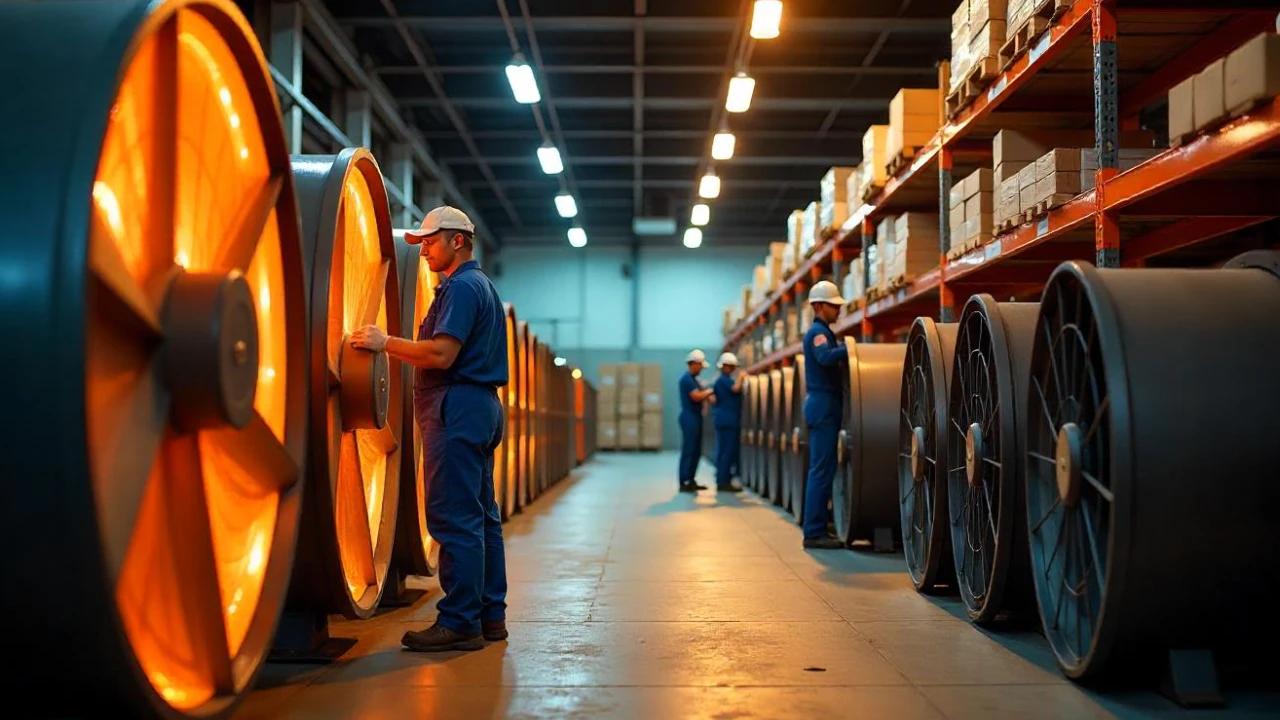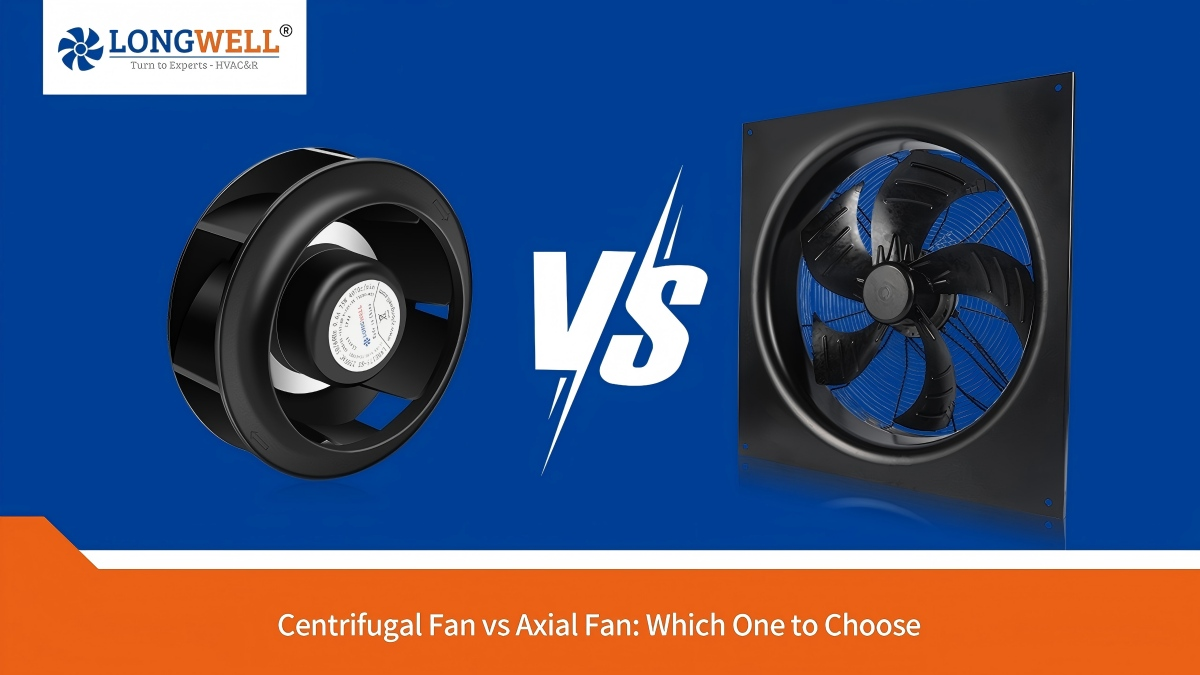
Introduction
Fans, as key equipment for air circulation and ventilation, play an indispensable role in both industrial production and everyday life. In recent years, driven by accelerated global industrialization and urbanization as well as growing demands for energy efficiency and air quality, the global fan market has been thriving. This broad market encompasses a wide range of products—from large-scale industrial fans and HVAC fans to axial fans (e.g., industrial fans, HVAC fans, axial fans)—serving a variety of sectors, including manufacturing plants, commercial HVAC systems, and data center cooling. Authoritative agencies predict that the fan market will maintain robust growth in the coming years, highlighting its significant future value. This article provides a systematic overview of the development background and growth forecast of the global fan market, delving into technological evolution, application expansion, market strategies, and competitive brand dynamics to offer valuable insights for industry professionals and industrial fan manufacturers as well as HVAC fan suppliers.
Market Overview and Growth Forecast
The global fan market is currently valued at several billions of dollars and is projected to climb even higher by the end of this decade. According to authoritative data, the fan and blower industry, which has benefited from building construction and industrial growth, is set to increase from approximately $6.73 billion in 2024 to $9.37 billion by 2029, with a compound annual growth rate (CAGR) of around 6.8%. Industrial fans, a key subsegment, were valued at about $5.7 billion globally in 2022; according to Zion Market Research, this figure could reach $8.9 billion by 2030, growing at a CAGR of about 5.2%. Meanwhile, ventilation fans—such as exhaust fans—have continued their steady upward trend in residential and commercial applications. The global market for ventilation fans is expected to reach $5.23 billion by 2030 with a CAGR of around 6.3% between 2025 and 2030. Overall, whether industrial-scale fans or commercial HVAC equipment, the market is expected to witness solid expansion in the coming years.
From a regional standpoint, the Asia-Pacific region currently constitutes the largest market for fans worldwide. In the industrial fan segment alone, Asia-Pacific accounted for roughly 33.8% of global revenue in 2022 and is likely to maintain its lead over the next decade. Manufacturing and infrastructure investments in emerging economies like China and India, alongside labor and raw material advantages in Vietnam and Indonesia, are fueling strong growth in the Asian fan industry. Additionally, Europe is projected to see the fastest growth, driven by soaring demand for ventilation equipment in medical and public buildings. For example, hospitals and clinics are installing more fans to ensure adequate air circulation, while increased needs in healthcare are substantially boosting the European fan market. North America is also experiencing steady growth due to upgrades in manufacturing and the ongoing data center construction boom. Meanwhile, the Middle East, Africa, and Latin America are poised for new growth opportunities as infrastructure developments and industrialization progress. Overall, fan demand across all major regions is on the rise, and by 2030, the global industry is expected to significantly surpass today’s scale, underscoring remarkable market potential and value.
It should be noted that along with the market’s rapid expansion, competition within the sector is intensifying. Manufacturers of industrial fans and HVAC fans worldwide are actively ramping up their capacity and focusing on technological research and innovation, aiming to stand out through product differentiation and secure larger market shares.
Technological Evolution and Innovation Trends
Confronted with extensive market prospects and mounting competition, the fan industry’s technological evolution primarily focuses on energy efficiency, intelligent control, advanced motors, and noise reduction. Several major innovation trends have emerged:
1. High Efficiency and Energy Saving
Boosting energy efficiency remains a core objective in fan technology development. Advances in materials science, aerodynamics, and motor control have significantly enhanced the energy performance of modern fans. For instance, refining blade design and using low-resistance ducts increase airflow-to-power ratios. Additionally, stricter governmental regulations worldwide incentivize upgrades to meet tighter energy efficiency standards. Employing variable-frequency drives (VFDs) can dynamically adjust fan speeds based on real-time needs, thus preventing unnecessary power consumption. Studies indicate that reducing fan speed by 20% can slash power usage by up to 50%. More and more manufacturers are also adopting EC (electronically commutated) brushless motors in place of traditional AC motors. EC motors exhibit higher efficiency and produce less heat at partial loads, resulting in further energy savings for the overall fan system. According to agencies like the International Energy Agency, industrial motor systems account for a significant share of total industrial energy consumption, and fans are one of the key applications. Consequently, promoting high-efficiency fans is crucial to achieving global carbon reduction goals.
2. Intelligent Control
With rapid adoption of IoT technologies, fans are increasingly equipped with additional sensors and intelligent control modules for remote monitoring, self-adjusting speed, and predictive maintenance. Under Industry 4.0, smart fans can be networked to central control systems or cloud platforms, automatically regulating speed and airflow based on real-time data to meet on-site demands. This digital, intelligent integration both boosts fan performance and curbs downtime, prolonging equipment lifespan. Through dedicated apps or computer dashboards, operators can effortlessly track vibration and temperature data, preempting maintenance needs. Industrial IoT (IIoT) applications in fans represent a standout trend in the field, and in building HVAC systems, smart fans can interface with building management systems (BMS) to automatically adjust ventilation in response to CO₂ levels or foot traffic, simultaneously optimizing indoor air quality and saving energy.
3. Advanced Motor Applications (EC Motors)
EC motors, or electronically commutated DC motors, are highly efficient and easily controlled, driving widespread adoption across the fan product spectrum. Compared with traditional asynchronous motors, EC motors excel in partial load and variable-speed conditions, and their built-in controllers facilitate intelligent speed regulation. Many HVAC fansand data center fans already employ EC motors, significantly reducing energy usage. EC motors are also smaller and quieter, which aids in the compact, low-noise design of fan units. Matching consumer demands for energy-efficient fans, many leading manufacturers are incorporating EC motors as a key selling point, and adoption is projected to keep growing until it becomes an industry standard in both commercial and industrial segments.
4. Noise Reduction
As regulatory noise limits tighten and consumer comfort expectations rise, low-noise fan design has become a research focal point. Manufacturers employ improved blade geometries, new materials, and noise suppression structures to reduce operational noise. For example, blades inspired by biomimicry can minimize vortex noise, while silencers and vibration-reduction components further dampen sound. Across HVAC and data centers, limiting noise is especially critical—fans that operate quietly not only promote a comfortable environment but also underscore superior product quality and technological refinement. Reports indicate that noise minimization is now a top priority in fan engineering, influencing product development and performance benchmarks.
Apart from these focus areas, fan technology continues to evolve toward greater reliability and maintainability—from modular designs that streamline part replacement to cutting-edge bearings and corrosion-resistant materials for harsh conditions. All these efforts help fan manufacturers build more competitive solutions to meet diverse global demands.
Application Expansion
The sustained growth in the fan market is inextricably linked to escalating demands across multiple industries. Today, fan usage is expanding from traditional settings into more diversified domains, playing pivotal roles in various sectors:
1. Manufacturing & Industrial Production
In factory workshops, mining sites, and power stations, fans are essential for ventilation, cooling, and dust removal—critical to ensuring safe production conditions and stable operations. Ongoing global manufacturing expansion and rising safety standards are fueling significant demand for industrial ventilation equipment. On one hand, many countries have strengthened occupational safety regulations, requiring better air quality controls in factories to remove hazardous dust and fumes. For example, heightened awareness of dust-related occupational diseases has driven stricter regulations, spurring widespread adoption of industrial fans. On the other hand, newly built or upgraded facilities in sectors like steelmaking, chemicals, and automotive require high-performance fans for cooling and exhaust. As global industrial output grows and “smart factories” emerge, demand for reliable, high-efficiency industrial fans will remain strong, underpinning long-term market growth.
2. HVAC in Buildings
Fans form the backbone of heating, ventilation, and air conditioning (HVAC) systems in commercial buildings, offices, hospitals, shopping centers, and other facilities. Worldwide urbanization has led to a tremendous rise in building floor space, creating a constant demand for new HVAC fan installations. According to Global Construction Perspectives and Oxford Economics, global construction output will surge 85% by 2030 from 2020 levels, reaching $15.5 trillion. This construction boom translates into equally robust prospects for HVAC ventilation systems. Concurrently, heightened efficiency standards prompted by climate change are pushing the renovation of outdated buildings, upgrading them with more efficient fans and smarter controls. For fan manufacturers, the building HVAC sector is both voluminous and highly demanding, particularly when it comes to energy efficiency and noise control—resulting in fierce technical innovation and brand competition. With a range of specialized fans (from high-rise air-conditioning units to parking garage exhaust fans or hospital cleanroom systems) being rapidly adopted, HVAC remains among the most dynamic segments of the global fan industry.
3. Data Centers & IT Cooling
The rise of the digital era has sparked an exponential increase in data centers worldwide. Servers produce enormous heat loads, requiring robust cooling solutions where fans play a central role. The growing demand in cloud computing, AI, and 5G has simultaneously created a new blue-ocean opportunity in data center cooling fans. MarketsandMarkets research shows that the global data center cooling market, valued at $12.7 billion in 2023, is forecast to reach $29.6 billion by 2030 at a CAGR of 12.8%. While data center cooling involves multiple technologies (e.g., CRAC units, liquid cooling), air-based cooling still relies heavily on fans—from small internal server fans to powerful axial or centrifugal fans in HVAC units. As server power density rises and environmental regulations call for greener, more energy-efficient operations, data centers are adopting more advanced cooling methods, such as intelligent fan walls or fans that switch on and off as needed. Fan reliability, energy efficiency, and integrated smart monitoring are critical in this environment, prompting manufacturers to design specialized products to meet data center requirements.
4. Agricultural Ventilation & Environmental Management
Ventilation is equally vital in modern agriculture, from temperature- and humidity-controlled greenhouses to livestock operations. The global rise in indoor farming and large-scale livestock rearing—driven by population growth and climate change—propels demand for specialized agricultural ventilation fans. According to Grand View Research, the agricultural ventilation fan market was valued at $755 million in 2022 and is expected to grow at a CAGR of 9.7% between 2023 and 2030. This rapid expansion stems from new farming practices like vertical farms and hydroponic greenhouses, which require controlled microenvironments for optimal plant growth. Likewise, high-volume exhaust fans and cross-flow fans help remove ammonia and moisture in livestock environments, ensuring animal welfare. Advanced agriculture fan technology—such as heat-recovery or ECplus energy-saving fans—can even save over 80% of energy consumption in settings like dairy farms. While challenges remain in promoting these innovations in less-developed areas, agriculture represents a fast-emerging niche within the broader fan market, deserving serious consideration from industry players.
Collectively, these diverse applications bring powerful momentum to the global fan market. The overlapping drivers—expanding industrial capacity, rising construction, new IT infrastructure, and modernizing agriculture—are fueling concurrent growth in fan solutions across numerous industries. This application diversity also helps minimize the impact of fluctuations in any single segment, supporting a healthy and balanced market expansion.
Global Market Strategies
As new international market opportunities emerge, fan manufacturers are dynamically adjusting their strategies to broaden their global footprint. For companies looking to venture overseas, digital marketing and cross-border channels have become indispensable. Below are several commonly adopted strategies for global market expansion:
• Digital Marketing & SEO
As the digital era takes hold, online channels are becoming the principal route for reaching international clientele. Studies indicate that up to 90% of B2B buyers source new suppliers online. This underlines the necessity for fan manufacturers to develop a strong digital brand image and marketing network to connect with potential customers worldwide. Tactics include building multilingual websites with search engine optimization (SEO), focusing on keywords such as “industrial fan manufacturer,” “HVAC fan supplier,” and “axial fan supplier” in both Chinese and English to improve their rankings on Google, Bing, and other major search engines. Technical aspects, like page load speed optimization and mobile responsiveness, are also critical to retaining prospects. Meanwhile, content marketing is increasingly vital in B2B contexts—studies show that buyers read an average of 13 pieces of content before contacting sales, and up to 60% of purchase decisions can be made solely on digital content. As such, publishing high-quality blog posts, industry reports, white papers, and case studies regularly helps position a company as an authoritative source, thereby attracting and retaining prospects. Moreover, leveraging authoritative endorsements—such as certificates, prominent customer logos, and media citations—on the website further boosts brand credibility among global buyers.
• Online Advertising
Besides SEO, paid online advertising remains an efficient means to secure overseas leads. Google Ads lets fan companies bid on specific keywords to appear at the top of search results, targeting users with immediate purchase interest. For example, foreign buyers searching for “industrial fan manufacturer” might first see an ad linking to a supplier’s landing page. Likewise, LinkedIn Ads are effective for B2B marketing in the industrial sphere: fan manufacturers can target engineers, purchasing managers, or industry executives with messages about their product advantages and solutions. This pay-per-click format offers controlled investment with quick results, ideal for tapping new markets or promoting new products. Naturally, such campaigns require compelling landing pages and clear contact channels to maximize conversion rates.
• Cross-Border E-Commerce & Direct Website Sales
As global e-commerce infrastructure expands, direct online sales of industrial goods are growing more prevalent. An increasing number of procurement managers prefer searching, evaluating, and sometimes even completing purchases online, prompting fan makers to build cross-border e-commerce channels. Some companies launch online stores on their official websites, offering product catalogs, spec lookups, price inquiries, and live chat. Alternatively, third-party e-commerce platforms (e.g., Amazon Business, eBay Industrial) can broaden market reach with established logistics and payment solutions. Smaller ventilation products and parts that can be shipped by standard delivery fit neatly into this model, while larger custom projects may still require offline negotiations, using online channels primarily for lead generation. Whatever the approach, maintaining a robust online sales channel has become an industry best practice for international market expansion. Companies must have reliable cross-border logistics, multilingual support, and compliance with local standards to ensure positive customer experiences.
• B2B Platforms & Industry Gateways
Beyond self-operated channels, major B2B marketplaces like Alibaba, Global Sources, and Made-in-China help vendors access worldwide buyers quickly. By setting up detailed product listings and company profiles, fan manufacturers can boost visibility and inquiries from multiple regions—be it Europe, the Middle East, or Africa. A presence on these platforms often demands active management, prompt responses to inquiries, and up-to-date product information, but it can substantially decrease the cost of acquiring new leads. Industry-specific platforms and forums focused on HVAC or industrial equipment can also be worthwhile. In short, leveraging third-party B2B platforms can open the door to global markets for small and mid-sized fan manufacturers, enabling them to establish an international presence with relatively limited resources.
• Overseas Exhibitions & Offline Development
Despite the rise of digital channels, international trade shows remain vital in the industrial sector for client acquisition and brand demonstration. Annual events like the AHR Expo (USA), Hannover Messe (Germany), or The Big 5 (Dubai) attract a global audience of distributors, engineering firms, and end users. By exhibiting, companies can showcase the latest product offerings—such as advanced axial fans or energy-saving designs—explain their technological advantages, and generate valuable leads. These exhibitions also provide unique opportunities to observe competitors and gauge industry trends. Potential clients identified at these shows are often followed up via email, LinkedIn, and other channels to deepen the relationship toward eventual deals. Moreover, companies can consider establishing local offices or collaborations with local distributors in key overseas markets, delivering localized after-sales support and service, which further cements trust and fosters long-term growth. A synergy of online and offline marketing can dramatically amplify brand exposure and sales success in international arenas.
All in all, successful global expansion relies on an integrated blend of tactics. Research shows that about 80% of B2B transactions now involve digital channels—meaning that robust online marketing and e-commerce infrastructure are no longer optional. Combining these with traditional networks and trade events yields a balanced approach to tapping opportunities across diverse markets.
Brand Building and Competitive Strategy Analysis
The global fan market features stiff competition from established giants and emerging players alike. To stand out, manufacturers need not only strong product offerings but also well-crafted brand and competitive strategies. Leading international companies typically excel in technical R&D, quality control, and customer service, leveraging consistent brand-building to win customers’ confidence. Take Greenheck and Systemair in North America or ebm-papst in Germany, for instance: these long-standing brands have earned recognition for large-scale HVAC fans and industrial ventilation systems. They highlight reliable performance, compliance with strict standards (like AMCA certification), and extensive local service networks, consolidating their global market positions. These players also invest heavily in digital branding—via websites, social media, and search marketing—to maintain their expertise-driven image. In the current marketplace, keyword ranking, professional endorsements, and customer testimonials are key pillars of effective brand building.
Among Chinese fan manufacturers, Longwell Fans stands out with a unique approach to brand and competitive strategy. As an experienced industrial fan manufacturer, Longwell Fans offers a comprehensive lineup ranging from axial fans and centrifugal fans to cross-flow designs, with a strong focus on building HVAC solutions. In overseas markets, it is regarded as a dependable HVAC fan supplier. Innovation and quality form the company’s foundation, as reflected in the development of several highly efficient fan products. For example, Longwell Fans employs cutting-edge EC brushless motors and aerodynamically optimized blades to improve efficiency and reduce noise; their heat-recovery ventilation fans reclaim waste heat from industrial processes, achieving over 75% energy savings versus conventional units. Such proven technological strengths grant Longwell Fans a competitive edge and steadily grow its international profile.
Building customer trust hinges on consistent product quality and service. Longwell Fans adheres to strict production standards like ISO9001, ensuring every export product meets European CE, RoHS, and North American UL certifications, among others. These authoritative certifications facilitate entry into global markets and reassure buyers of product safety and reliability. Moreover, the firm highlights real customer feedback and collaborative projects—such as large-scale factory ventilation retrofits or ongoing supply arrangements with well-known corporations—to reinforce its credibility among new clients. On the support side, Longwell Fans has assembled an expert technical team offering multilingual assistance for product selection, installation, and after-sales service worldwide. These thoughtful service measures bolster Longwell Fans’ reputation among overseas clients.
Strategically, Longwell Fans integrates technology and marketing in a two-pronged approach. On the R&D front, the company invests in cutting-edge technologies—such as intelligent control systems—and participates in shaping industry standards, seeking to maintain technical leadership in energy efficiency and performance. Meanwhile, it actively engages in international events and partnerships: attending major trade fairs, collaborating with global distributors, and tailoring products to local requirements, all of which enhance agility in competitive global landscapes. By fusing product excellence, digital marketing, and corporate integrity, Longwell Fans has forged a steady, understated path toward global success—boosting brand recognition and cultivating a loyal customer base.
Conclusion and Call to Action
All in all, the global fan market stands on the cusp of a new golden era. Demand is climbing worldwide, driven by industrial expansion, infrastructure growth, and ongoing technological innovation. Despite a competitive environment, fan manufacturers can stand out by focusing on energy-efficient and intelligent product development, coupled with sophisticated digital marketing and global channel strategies. As a front-runner, Longwell Fans embodies these strengths—demonstrating how an integrated, international outlook and strong technical know-how can set a standard for fan manufacturers aiming to expand their global reach. Looking ahead, the future holds immense promise for those prepared to adapt and innovate, and the fan industry is poised for even greater achievements by 2030 and beyond.
If you’re interested in learning more about the fan industry—its technical solutions, case studies, and emerging trends—please visit the Longwell Fans official website to access white papers, customer success stories, and more detailed information. Let’s embrace these latest developments and, together, drive the fan industry toward a higher-efficiency, more intelligent, and sustainable future!



